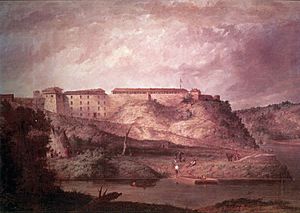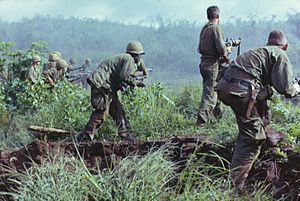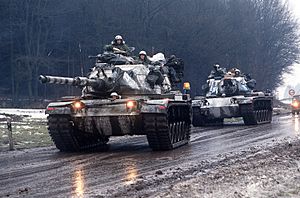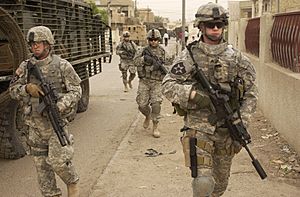History of the United States Army facts for kids
The history of the United States Army began in 1775. The United States Army is the main land-based part of the U.S. Armed Forces. Its main jobs are fighting land battles and managing occupied areas. The Army Corps of Engineers also helps control rivers in the United States.
The Continental Army was created during the American Revolutionary War. It was needed to fight the British Army. Before the 1940s, the Army was quite small during times of peace. In 1947, the Air Force became its own separate branch. The Army was controlled by the War Department until 1947. Since then, it has been under the Defense Department.
The U.S. Army has fought in many major conflicts. These include the War of 1812 (1812–15) and the American Civil War (1861–65). It also fought in the Spanish–American War (1898) and World War I (1917–18). Later, it took part in World War II (1941–45), the Korean War (1950–53), and the Vietnam War (1965–71). After the Cold War ended in 1991, the Army focused on Western Asia. It fought in the 1991 Gulf War and the war in Iraq. It also took part in the war in Afghanistan.
When the American Revolutionary War started in April 1775, the colonists had no official army. They relied on local militias. These were made up of part-time citizen-soldiers. Congress first approved ten companies of riflemen. The first full regiment of regular infantry was formed in June 1784. After the war, the Continental Army was quickly disbanded. Americans did not trust large standing armies. State militias became the main ground force. Only a small regiment guarded the Western Frontier. One artillery battery protected the arsenal at West Point.
During the War of 1812, an invasion of Canada failed. This was partly because state militias were widely used. U.S. troops could not stop the British from burning Washington, D.C.. However, the Regular Army, led by Generals Winfield Scott and Jacob Brown, showed its skill. They won battles in the Niagara campaign of 1814. Between 1815 and 1860, the Army mainly fought Native Americans in the West. It also guarded coastal artillery stations. The U.S. Army used both regular and volunteer units in the Mexican–American War (1846–48).
At the start of the American Civil War, the regular U.S. Army was small. It mostly defended the frontiers from Indian attacks. After the Civil War, the Army fought more wars with Native Americans. They resisted U.S. expansion across the continent.
A combined force of drafted and volunteer soldiers was formed in 1917. This "National Army" fought in World War I. During World War II, the "Army of the United States" took its place. The end of World War II led to the Cold War. When the Korean War began, NATO was formed to defend Western Europe. During the Cold War, American troops fought communist forces in Korea and Vietnam. The 1980s focused on reorganization. The Army became an all-volunteer force. It emphasized better training and technology. By 1989, the Cold War was ending. The Army planned to reduce its size. After Desert Storm, the Army had no major combat until the 2000s. After the September 11 attacks, the U.S. and NATO invaded Afghanistan in 2001. They replaced the Taliban government. The Army also took part in the 2003 invasion of Iraq.
Contents
Continental Army: America's First Soldiers
The Continental Army included troops from all 13 colonies. When the American Revolutionary War started in April 1775, the colonists had no official army. Before this, each colony relied on its militia. These were part-time citizen-soldiers for local defense. Sometimes, temporary "provincial regiments" were raised for specific problems.
As tensions with Britain grew, colonists began to train their militias. Training increased after the Intolerable Acts in 1774. Some colonists suggested creating a national militia. But the First Continental Congress rejected this idea.
On April 23, 1775, Massachusetts approved raising a colonial army. Other colonies like New Hampshire, Rhode Island, and Connecticut soon followed. On June 14, 1775, the Second Continental Congress decided to create a Continental Army. They adopted the forces already near Boston (22,000 troops) and New York (5,000). They also raised the first ten companies of Continental troops. These were riflemen from Pennsylvania, Maryland, Delaware, and Virginia. They served for one year and became the 1st Continental Regiment in 1776. On June 15, George Washington was chosen as Commander-in-Chief. Most enlisted soldiers were young, poor, and often of Irish or German background. About one in ten were African American.
Washington successfully forced the British out of Boston in 1776. But he was defeated and nearly captured later that year in New York City. After crossing the Delaware River in winter, he won two key battles. These were at Trenton and Princeton. These victories retook New Jersey and boosted American morale.
Thanks to his strategy, American forces captured two major British armies. One was at Saratoga in 1777. The other was at Yorktown in 1781. Historians praise Washington for choosing good generals. He also kept up morale and held the army together. He worked with state governors and militias. He paid attention to supplies, logistics, and training. After winning in 1783, Washington resigned his command. He did not try to seize power, showing his commitment to American republicanism.
Organization of the Continental Army
Congress first approved ten companies of riflemen. The first full regiment of regular infantry was formed in June 1784.
After creating the Continental Army, Congress set up departments on June 16, 1775. These departments supported the Army's operations. They later became Corps: the Adjutant General's Corps, the Army Corps of Engineers, the Finance Corps, and the Quartermasters Corps. Congress also approved Field Artillery and Cavalry units.
The Continental Army changed over time:
- 1775 Army: This was the first New England Army. Washington organized it into divisions, brigades, and regiments. Major General Philip Schuyler's regiments in New York invaded Canada.
- 1776 Army: This army was reorganized after the first enlistment periods ended. It still focused on the Northeast. It had 36 regiments, each with 768 men.
- 1777–80 Army: This period saw important reforms. Britain was sending huge forces to end the war. Congress ordered each state to provide one-battalion regiments. Washington could also raise 16 more battalions. Enlistment terms were extended to three years or "the length of the war." This helped avoid yearly crises when soldiers' terms ended.
- 1781–82 Army: This was a tough time for the Americans. Congress was out of money. It was hard to replace soldiers whose terms expired. Support for the war was low. Washington had to stop mutinies in the Pennsylvania Line and New Jersey Line. Congress cut Army funding. But Washington still secured important victories.
- 1783–84 Army: This army was replaced by the United States Army, which still exists today. As peace with Britain was made, most regiments were disbanded.
Besides the Continental Army, local militia units also fought. These were raised and funded by individual colonies or states. They often supported the Continental Army regulars during campaigns.
Early Years of the Nation (1783–1812)
After the Revolutionary War ended in 1783, a committee suggested a permanent armed force. George Washington proposed a small force of only 2,631 men. This force would guard the western frontier and borders with Canada and Florida. But money problems meant the new nation relied heavily on state militias. The Continental Army was quickly disbanded. Only the First American Regiment guarded the Western Frontier. One artillery battery protected West Point's arsenal.
However, conflicts with Indians continued. It soon became clear that a trained standing army was needed. The first such army, the Legion of the United States, was formed in 1792. It was led by Major Gen. Anthony Wayne. The Legion trained at Legionville in Pennsylvania. In 1793, it moved to Ohio. It was joined by units from the Kentucky Militia. Their mission was to advance into Indian territory. They aimed to establish U.S. control over northern and western Ohio.
The northern campaign ended with a victory at the Battle of Fallen Timbers in August 1794. This battle was near modern-day Toledo, Ohio. The legion then advanced to Kekionga in northern Indiana. They established Fort Wayne there. The Treaty of Greenville in 1795 brought peace to northern Ohio. It opened eastern and southern Ohio for settlement. The legion also built other forts, like Fort St. Mary's.
After Wayne's death in 1796, the Legion was renamed the United States Army.
19th Century Army History
War of 1812
The War of 1812 was the second and last American war against the British. It was less successful than the Revolution. An invasion of Canada failed. This was partly due to relying too much on state militias. U.S. troops could not stop the British Army from burning Washington, D.C.. However, the Regular Army, led by Generals Winfield Scott and Jacob Brown, proved its professionalism. They won tactical victories in the Niagara campaign of 1814. The nation celebrated a great victory by Southern militia. This was under Andrew Jackson at the Battle of New Orleans in January 1815. This ended the war on a positive note.
The failures of the War of 1812 showed that the War Department needed reform. Secretary of War John C. Calhoun reorganized the department. He created a system of bureaus. Their chiefs held office for life. He also created a commanding general position in the field. Winfield Scott was the senior general through the 1840s and 1850s. The bureau chiefs advised the Secretary of War. They also commanded their own troops.
Calhoun set up the Bureau of Indian Affairs in 1824. This agency dealt with Native Americans. In 1849, it moved to the new Department of the Interior.
Westward Expansion and Indian Wars
Between 1815 and 1860, the Army's main job was controlling Native Americans in the West. It also manned coastal artillery stations. Most forces were on the frontier or at seaports.
Transportation was very important. The Army, especially the Army Corps of Engineers, improved river navigation. Steamboats made travel inexpensive on rivers like the Mississippi and Missouri. Army expeditions helped engineers improve this technology.
Seminole Wars
The main military action inside the U.S. involved years of fighting with the Seminole Indians in Florida. They refused to move west. They used the difficult terrain to defend themselves. The First Seminole War was from 1814 to 1819. The Second Seminole War was from 1835 to 1842. The Third Seminole War was from 1855 to 1858.
War with Mexico
The U.S. used regular and volunteer units to fight Mexico from 1846–48. The American plan had three parts. First, take control of the Southwest (New Mexico and California). Second, invade Mexico from the North under General Zachary Taylor. Third, land troops and capture Mexico City with an army under General Winfield Scott. All operations succeeded. Americans won all major battles.
The army grew from 6,000 regulars to over 115,000. About 1.5% were killed in fighting. Nearly 10% died of disease. Another 12% were wounded or discharged due to illness.
Civil War: A Nation Divided
At the start of the American Civil War, the regular U.S. Army was small. It mostly defended frontiers from Indian attacks. As Southern states left the Union, many experienced officers joined the Confederate States Army. This further weakened the regular army.
The attack on Fort Sumter began the war. Both sides recruited many men into new Volunteer Armies. Regiments were recruited locally. Company officers were elected by the men. Colonels were often local politicians. Generals were appointed by President Abraham Lincoln.
The Volunteer Army was much larger than the Regular Army. New units had to be formed. The plan involved geographical areas called theaters. Armies, named after rivers, fought in these theaters.
The rapidly growing armies were poorly trained at first. The first major battle was at Bull Run in 1861. The Union suffered an embarrassing defeat. Both sides then spent more time organizing and training. Much of 1861 involved skirmishes between pro-Union and pro-Confederacy forces. These took place in border states like Missouri and Kentucky.
In 1862, the war became much bloodier. Neither side gained a lasting advantage. However, decisive battles in 1863 shifted the war. These were Gettysburg in the east and Vicksburg in the west. Union forces increasingly outnumbered and out-equipped the Confederates. The Union's larger population and economy became key factors. An effective naval blockade further hurt the Confederate war economy.
By 1864, Union advantages were overwhelming. Grant fought many bloody battles with Lee in Virginia. Lee's tactics caused high Union casualties. But Lee could not replace his losses. He was forced to retreat into trenches around Richmond, Virginia. Meanwhile, in the West, William Tecumseh Sherman captured Atlanta in 1864. His March to the Sea destroyed a wide area of Georgia. In 1865, the Confederacy collapsed. Lee surrendered to Grant at Appomattox Courthouse.
In total, 2.2 million men served in the Union army. 360,000 died from all causes. Two-thirds died from disease. The Volunteer Army was disbanded in summer 1865.
Army Supplies and Support
The Confederacy struggled with a lack of supplies. Union forces usually had enough food, supplies, and weapons. The Union supply system stayed efficient, even deep in the South. Quartermaster General Montgomery C. Meigs was a key leader. Union quartermasters managed most of the $3 billion spent on the war. They worked from sixteen major depots. These depots handled buying and supplying goods. The system was complex. It involved the Army, government factories, and private businesses. Congress watched the system closely. They wanted to ensure their districts got contracts.
African American Soldiers
Lincoln's Emancipation Proclamation of January 1, 1863, allowed African Americans to join the Union Army. About 190,000 volunteered. This increased the Union's numerical advantage. Black Union soldiers mostly served in garrison duty. But they fought in several battles. These included the Battle of the Crater (1864) and the Battle of Nashville (1865).
There was strong animosity between Confederates and black soldiers. At Fort Pillow on April 12, 1864, Confederate units massacred black soldiers trying to surrender. This further fueled tensions.
Indian Wars of the Late 19th Century
After the Civil War, the U.S. Army fought a series of wars with Native Americans. They resisted U.S. expansion into the continent's center. By the 1890s, the U.S. saw itself as a global player. The Army played a key role in winning the Spanish–American War of 1898. It also fought in the less known Philippine–American War of 1899–1901.
As settlement increased in the West after 1869, clashes with Native Americans intensified. The military's goal was to move free-roaming Indians onto reservations. Strong resistance from skilled, well-armed Indian warriors led to the Indian Wars.
In the Apache and Navajo Wars, Colonel Kit Carson forced the Mescalero Apache onto a reservation in 1862. Skirmishes continued until after 1900. In 1863–1864, Carson used a "scorched earth" policy in the Navajo campaign. He burned Navajo fields and homes. He also captured or killed their livestock. Other Indian tribes, enemies of the Navajos, helped him. Later in 1864, he fought a combined force of over a thousand Kiowa, Comanche, and Plains Apache. Carson retreated but destroyed an Indian village and winter supplies. In the Red River War, the U.S. Army systematically destroyed Comanche property. This led to the surrender of the last Comanche war chief, Quanah Parker, in June 1875.
In June 1877, during the Nez Perce War, the Nez Perce under Chief Joseph refused to give up their lands. They undertook a 1,200-mile fighting retreat. They battled about 2,000 American soldiers and volunteers. The Nez Perce were finally surrounded at the Battle of Bear Paw and surrendered.
The Great Sioux War of 1876–77 involved the Lakota under Sitting Bull and Crazy Horse. The conflict began after gold was found in the hills. The most famous battle was the Indian victory at the Battle of the Little Bighorn. Here, combined Sioux and Cheyenne forces defeated the 7th Cavalry, led by General George Armstrong Custer. By 1890, the West was mostly peaceful. Only small Indian raids occurred along the Mexican border.
Combat in the Indian wars resulted in about 4,340 deaths. This included soldiers, civilians, and Native Americans. In all Indian wars from 1790 to 1910, cavalry units fought in about 1,000 battles. They had over 2,000 killed and wounded. Disease and accidents caused far more Army casualties than combat.
Spanish–American and Philippine–American Wars
The Army played a central role in winning the Spanish–American War of 1898. It also fought in the less known Philippine–American War of 1899–1901.
20th Century Army History
Army Leadership and Reorganization
Elihu Root was United States Secretary of War from 1899–1904. He reformed the War Department. He expanded West Point and created the U.S. Army War College. He also established the General Staff. He changed promotion rules and organized schools for Army branches. He also started the practice of rotating officers between staff and field roles. General Samuel Baldwin Marks Young became the first chief of staff in 1903.
Before 1903, the senior military officer was the Commanding General of the United States Army. This general reported to the Secretary of War.
In 1910, the U.S. Signal Corps flew the Army's first aircraft. This was the Wright Model A biplane.
The Maneuver Division was formed in San Antonio, Texas, in March 1911. It was meant for operations against Mexico during the Mexican Revolution. This was the first attempt to modernize the division concept. Major General Leonard Wood, then Army Chief of Staff, mobilized the division. He wanted to show Congress that the U.S. was not ready for modern warfare. The division was disbanded in August 1911.
Because of these difficulties, a new plan was made in 1913. Secretary of War Henry L. Stimson organized a "regular army ready for immediate use." He also planned for "national citizen soldiers" to reinforce the Regular Army. The U.S. was divided into four geographic departments. A regular army division was assigned to each. Twelve geographic districts each had a national guard infantry division.
In 1914 and 1916, U.S. troops went into Mexico. This was during the Mexican Revolution. The Pancho Villa Expedition tried to capture Pancho Villa. He was a Mexican who attacked U.S. border towns. These border skirmishes became known as the Border War.
World War I: The Great War
A combined drafted and volunteer force, the National Army, was formed in 1917. It was created by the U.S. War Department to fight in World War I. The National Army was built on the regular United States Army. It was strengthened by the United States National Guard and a large draft of men.
The Selective Service Act of 1917 set up the Army's structure. It had three parts:
- The Regular Army, to be quickly brought to full wartime strength.
- The National Guard, also to be quickly expanded.
- A National Army, to be created in two groups of 500,000 men each.
Over time, the identities of these three parts blended. Recruits and draftees joined all units. By mid-1918, all land forces were called the "United States Army." But their original group was still shown by their unit numbers. For example, Regular Army divisions were numbered up to 25. National Guard divisions were 26 through 49. National Army divisions were 50 and higher.
At its largest, the National Army had over six million men. Two million of them fought on the Western Front. Promotions within the National Army were very fast. Many U.S. Army officers received double or triple promotions in just two years. For example, Dwight D. Eisenhower entered as a captain and was a lieutenant colonel a year later. Douglas MacArthur also rose quickly, from major to brigadier general in two years.
The Army entered World War I with very large divisions. They often had over 30,000 men. Each division had two infantry brigades, three artillery regiments, and an engineer regiment.
The United States joined World War I in April 1917. After training, the first American Expeditionary Forces arrived in June 1917. Their first actions on the Western Front came in October 1917. U.S. troops helped in the Hundred Days Offensive. This offensive finally broke through the German lines. With the armistice on November 11, 1918, the Army reduced its forces again.
Between the World Wars
The National Army was disbanded in 1920. All personnel returned to their Regular Army status. For example, George S. Patton, a colonel in the National Army, returned to the Regular Army as a captain. Some, like Douglas MacArthur, kept their wartime rank. But they often stayed at that rank for years. This caused talented officers to leave the service.
After World War I, the Army faced stagnation. The National Defense Act of 1920 allowed a Regular Army of 296,000 men. But Congress provided less funding. The National Guard and Organized Reserves also did not reach their authorized sizes. The Army's main problem was money. Congress only gave about half the funds the General Staff requested. This meant infantry and cavalry divisions became very small.
Between 1923 and 1939, divisions declined as fighting units. The War Department limited training. This made it hard to train units as combined teams.
World War II: Global Conflict
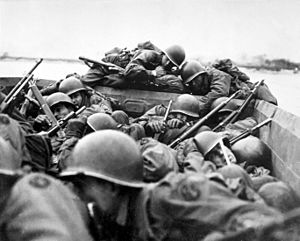
During World War II, the Army of the United States was formed. It combined Regular Army, National Guard, and drafted forces. It also included Reserve forces. The Army doubled in size between the invasion of Poland and the attack on Pearl Harbor. It grew 44 times between the U.S. entry into the war and the surrender of Japan.
The Army fought World War II with more flexible divisions. Most soldiers spent their time training in the U.S. Large numbers went overseas in 1944.
The United States entered World War II after the Japanese attack on Pearl Harbor in December 1941. On the European front, U.S. Army troops were key in capturing North Africa and Sicily. They later fought in Italy. On D-Day, June 6, 1944, and in the liberation of Europe, millions of U.S. Army troops played a central role. In the Pacific, Army soldiers helped the U.S. Marine Corps in the "island hopping" campaign. This took Pacific Islands from Japanese control. After the Axis surrenders in 1945, Army troops occupied Japan and Germany.
The United States Army Air Forces had been almost independent during the war. In 1947, it became the separate United States Air Force.
In 1948, the Women's Armed Services Integration Act gave women permanent status in the Army.
Cold War: A New Kind of Conflict
The end of World War II led to the Cold War. This was a confrontation between East and West. When the Korean War began, concerns about Western Europe's defense grew. Two corps, V and VII, were reactivated in 1950. American strength in Europe grew from one division to four. Hundreds of thousands of U.S. troops stayed in West Germany until the 1990s. They were ready for a possible Soviet attack.
During the Cold War, American troops fought Communist forces in Korea and Vietnam. The Korean War began in 1950. The Soviets left a U.N. Security Council meeting, removing their veto. Under a United Nations umbrella, U.S. troops fought to prevent North Korea from taking over South Korea. After advances and retreats by both sides, and China's entry, the Korean Armistice Agreement ended the war in 1953. It returned the peninsula to its previous state.
During the 1950s, the Army changed its organization. The basic tactical unit shifted from the regiment to the five-company battle group. Armored divisions kept their structure. Instead of brigades, they had three Combat Commands.
In 1960, the Army Chief of Staff ordered a review of division organization. This led to the Reorganization of Army Divisions (ROAD) program. By 1965, all types of divisions had a similar structure. They had three brigades with three (sometimes four) battalions. The ROAD division could mix armor and infantry battalions. This met the specific needs of a mission.
Vietnam War
The Vietnam War is often seen as a difficult time for the Army. It used many drafted soldiers. The war was unpopular with the American public. Also, U.S. political leaders placed restrictions on the Army. American forces controlled the traditional battlefield. But they struggled against the guerrilla tactics of the Viet Cong and North Vietnamese Army. For example, in the Tet Offensive in 1968, the U.S. Army turned a large attack into a major defeat for the Viet Cong. This weakened the guerrilla force. After that, most large battles were fought with the regular North Vietnamese Army. In 1973, public opposition forced a U.S. withdrawal. In 1975, Vietnam was unified under a communist government.
During the 1960s, the Department of Defense reviewed reserve forces. In 1967, Secretary of Defense Robert McNamara cut the number of Army National Guard combat divisions. He reduced them from 15 to 8 divisions. But he increased the number of brigades. The states were unhappy about losing divisions. However, no total reduction in Army National Guard strength occurred. This convinced the governors to accept the plan.
After Vietnam: A New Era
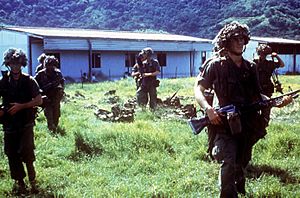
After the Vietnam War, General Creighton Abrams adopted a "Total Force Policy." This treated the Regular Army, Army National Guard, and Army Reserve as one force.
Training and Doctrine Command (TRADOC) was created in 1973. It took over doctrine development and individual training. U.S. Army Forces Command (FORSCOM) took over operational command of divisions and corps.
The 1980s focused on reorganization. The Army became an all-volunteer force. It emphasized training and technology. The Goldwater–Nichols Act of 1986 created Unified Combatant Commands. This brought the Army together with other military branches under unified commands. The Army also took part in invasions of Grenada in 1983 (Operation Urgent Fury) and Panama in 1989 (Operation Just Cause).
By 1989, the Cold War was ending. The Army planned to reduce its size. In 1990, Iraq invaded Kuwait. U.S. land forces quickly deployed to protect Saudi Arabia. In January 1991, Operation Desert Storm began. A U.S.-led coalition deployed over 500,000 troops. Most were from U.S. Army units. They quickly drove out Iraqi forces in one hundred hours.
1990s: Peacekeeping and Changes
After Desert Storm, the Army had no major combat operations for the rest of the 1990s. Army units participated in peacekeeping activities. One was the UN peacekeeping mission in Somalia in 1993. The Operation Gothic Serpent led to the deaths of eighteen American soldiers. This resulted in the withdrawal of international forces. The Army also sent troops to NATO peacekeeping forces in the Yugoslav Wars from December 1995. U.S. Army forces left Bosnia and Herzegovina in 2004. U.S. Army troops remain in Kosovo.
During the first half of the 1990s, the Army deactivated 8 of its 18 active divisions. It also deactivated two of its ten National Guard divisions.
In the mid-to-late 1990s, the Army tested Force XXI. This included Task Force 21. It was a digitized brigade formed to test new concepts and technology. Technologies tested included Software-defined radios, computers, and UAV technology.
21st Century Army History
On September 11, 2001, 53 Army civilians and 22 soldiers were killed at the Pentagon. This was during a terrorist attack when American Airlines Flight 77 crashed into the building. Lieutenant General Timothy Maude was the highest-ranking military official killed.
In response to the September 11 attacks, U.S. and NATO forces invaded Afghanistan in October 2001. This was part of the Global War on Terror. They replaced the Taliban government.
The Army also took part in the combined U.S. and allied 2003 invasion of Iraq. Within months, the mission changed from regular warfare to counterinsurgency. This resulted in thousands of U.S. service members killed or injured.
Most of the units that fought the ground campaign in Iraq were from the Army. They have since performed many operations against insurgents.
The Army has made adjustments to meet demands on its personnel and equipment. It used a stop-loss policy. This required more combat personnel to serve more tours of duty. This was due to the need for experienced soldiers. Unlike the Vietnam War, there was no involuntary draft. Instead, the Army mobilized Army National Guard and Army Reserve units. They were often deployed repeatedly to the combat zone.
This intense pace raised concerns about the psychological health of U.S. soldiers.
During the insurgency, many Army and Marine Corps vehicles, like HMMWVs, lacked sufficient armor. Efforts were made to add more armor to protect against improvised explosive devices. Some soldiers added their own armor, called hillbilly armor. HMMWVs in Iraq were replaced by Category 1 MRAP vehicles. These included the Force Protection Cougar H and the International MaxxPro.
The lack of stability in Iraq led to longer deployments for troops. U.S. troops withdrew in December 2011. But fighting continues. 3,293 U.S. Army personnel were killed in the conflict.
The Army's main modernization plan was the Future Combat Systems program. Many systems were canceled. The remaining ones were moved into the BCT modernization program.
Personnel Numbers
- 1775–1783: 17,000 (Continental Army without militias)
- 1784: 700 (First American Regiment)
- 1793: 5,100 (Legion of the United States)
- 1812: 7,000
- 1815: 35,800
- 1846: 8,600
- 1848: 32,000
- 1861: 16,400 (Regular Army, before the American Civil War)
- 1865: 1,000,516 (Union Army)
- 1898: 25,000
- 1917: 286,000
- 1939: 189,800
- 1945: 8,267,958
- 2017: 460,000
Images for kids


